Speaking to analysts during the Q1 FY 19-20 earnings calls on Tuesday ZEEL MD & CEO Punit Goenka and the Head of Corporate Strategy and Investor Relations Bijal Shah said that the new tariff order had allowed ZEEL to significantly improve its monetization and has also led to an improvement in subscription revenue growth.
When asked as to whether it was ZEELs strategy with the MSOs or its channels and the genre it was focusing on behind the drastic change in the subscription growth from last quarter from a 4% to 46% kind of growth Bijal Shah said that last quarter had been negatively impacted by the disruption on account of implementation of tariff order. He said that Q1 saw a good part of the tariff order stabilization, though it is not fully settled.
Shah added that ” Despite having built significant viewership over last several years, our channels were really not priced in line with their popularity. Under the old Tariff Order, it would have been a long journey but the new Tariff Order gave us a chance to reset this pricing. So, that has allowed us to significantly improve our monetization. And on top of this, in this Tariff Order, discrimination between the platforms is not possible, which has also led to an improvement in subscription revenue growth. So, this is much more on expected lines. In fact, for the last 2-2.5 years, we have been guiding that Tariff Order will allow us to properly monetize the viewership which we have, and we are seeing that evolving the way we had envisaged.”
Responding to a question on the movement of carriage costs given that the way contracts are structured is different now Shah said: “As a result of the new Tariff Order, we have seen some decline in carriage cost also, which was already at negligible level but that has further declined.”
Adding to Shah’s comments Goenka said “So, in Tamil Nadu, our channel was priced at zero before the Tariff Order. But during the Tariff Order, we got the opportunity to revise the pricing to Rs. 10. So, that is how our strategy on pricing and not giving discounts has worked and that strategy has paid off.”
Goenka said “As I mentioned that they either we were free in certain markets or our pricing was not commensurate with our viewership share. Tariff Order gave us the opportunity to re-price our content. If you remember, the tariff has been frozen since, I think, 2003 or something. And, you know, no price change has been done since then, for any of our channels since they were launched. And therefore, this gave us an opportunity to re-price our content.”
When asked if the share from the end of the distributor to the broadcasters had basically improved he said ” I think to share from the last mile has improved for the entire value chain. I do not think it is just the share from the DPOs. ARPU improvement that has happened in the market overall also has benefitted.” Asked whether if some of the MSOs were not kind of pushing its channels and if ZEEL was relying more on the terms of the DTH revenue Goenka said that “It is pretty much-balanced approach right now. The market is pretty evenly split, like 45-55 in favor of MSOs today. And while we do not have deals with some MSOs, our deals with all DTH operators are in place. And at the end, now we are looking at consumers, we are not focusing on DPOs alone.” He added that the pull demand from the consumers was basically driving the growth.
Goenka also said that the industry had seen a decline in total growth in TV ad spends by 6% ex-sports. On a full-year basis, growth would be a high single-digit to very low double-digit as per Goenka. The next quarter is still looking soft, but I am quite hopeful that second half will pick-up on the back of the festive season. He expects domestic subscription revenue to grow in the mid-twenties.
When asked as to why ZEEL was not guiding for a 30% growth on the back of a quarter where subscription revenue grows at 35-40% and believing it will be mid-25 Punit Goenka said that “So, there is an assumption based on our bouquet rates, etc. that will be uptaken. Today, the revenue that you look at is on the basis of the composition of bouquet versus a-la-carte. If tomorrow, some of my a-la-carte channels were to be dropped and bouquets were to be replacing them, definitely my yields will come down, right? So, if you look at the Tariff Order, the DPOs uptake of our bouquet versus a-la-carte is differentiated. As you will appreciate, we still do not have deals with some of the DPOs. The moment we enter those deals, our yields, in terms of the drop from a-la-carte to bouquets will happen and therefore, we are guiding for a 25% kind of growth number, unlike what you are seeing in quarter one.”
He also added that 15-16 crores domestic subscription revenues were not collected or not provided for in the last quarter and came up in this quarter. When asked whether FTA strategy was the right strategy he said that “FTA strategy is absolutely the right strategy what we have undertaken because the impact that we are seeing on the growth on subscription revenue more than makes up for that loss. The advertising revenue is cyclical in nature whereas subscription revenue is far more sticky.” He added that 5-6% amount of revenue had been lost on the account of FTA channels.








